We celebrate the end of the year the only way we know how: through lists, essays, and mixes. Join us as we explore the music that helped define the year. More from this series
So, what was your favorite feud this year? Was it Brock Lesnar versus The Undertaker? No? Then how about Rusev against John Cena? No again? Okay, then maybe it was the epic rivalry that first began in 2014, when Sheamus dirtied his lips on Jiggler’s backside in a “Kiss My Ass” match? Still no? Right, well then maybe your favorite feud didn’t come from WWE at all; maybe your favorite feud of 2015 was actually Meek Mill versus Drake, which began when Mr. Robert Rihmeek Williams (figuratively) rubbed his ass on Mr. Aubrey Drake Graham’s face in a tweet that “called out” the Canadian rapper for not writing his own lyrics.
Yes, that’s your favorite beef, and it must have been a very titillating one indeed, since in 2015 the sheer quantity and “quality” of feuds reached new, glorious heights. There was the deadly conflagration that gripped Nicki Minaj and Taylor Swift, the Earth-shattering tête-à-tête between Nicki Minaj and Miley Cyrus, a similarly epochal war of words concerning Katy Perry and Taylor Swift, the slanging match launched by Fat White Family against Mac DeMarco, the quasi-bar fight between Jack White and The Black Keys’ Patrick Carney, Mark Kozelek’s Herculean attempt to take on the entire Ottawa CityFolk festival single-handedly, and even the rekindling of Heather Mill’s bad blood for Sir Paul McCartney.
In other words, 2015 was a good year for beef. It certainly wasn’t the first revolution around the Sun to treat us to cat fights between Twitter profiles and media-generated caricatures, yet it was arguably the first to justify the comparison of arguments involving musicians, artists, or so-called politicians to those involving pro wrestlers. It was the year when, following the precedents set by the less obviously contrived tiffs of 2013 and 2014, the “feud” became a fully integrated cog in the media circus, a simple yet inexpensive frame for repackaging non-news and idle twitter flatulence in a sexier outfit. Instead of providing anything in the way of substantive argumentation or interesting information, it became a vessel for performers to self-promote and for media outlets to increase their internet traffic. As such, it enticed clickers with the false promise of seeing the enviably famous defamed, shamed, and blamed, only to deliver a pantomime that served merely to heap yet more celebrity on their already famed shoulders.
And yet, even if “the feud” as a cultural phenomenon doesn’t appear to be disappearing any time soon, this year-end retrospective aims to analyze its emergence and existence. Linking its systematic assimilation into the music industry to the growth of social media and the shift in media economics, I’ll look at how it became a remarkably facile way to generate content and hype. I’ll also look at the mechanics of beefs, covering how they work and who they benefit, including the press and the performers. After that, I’ll explore the public’s morbid attraction to them and discuss why this attraction almost always obtains the opposite of what it seeks. Finally, I’ll suggest that, in a world witnessing the proliferation of identikit musicians and media providers with little to distinguish themselves from each other, feuds will similarly proliferate.
And very finally, I’ll propose that such beefs represent and exacerbate the dumbing down of music, art, and politics, a dumbing down that, far from being a desecration or dilution of popular culture, is one of its central roles.
Feuds in the Pre-Digital Media Age
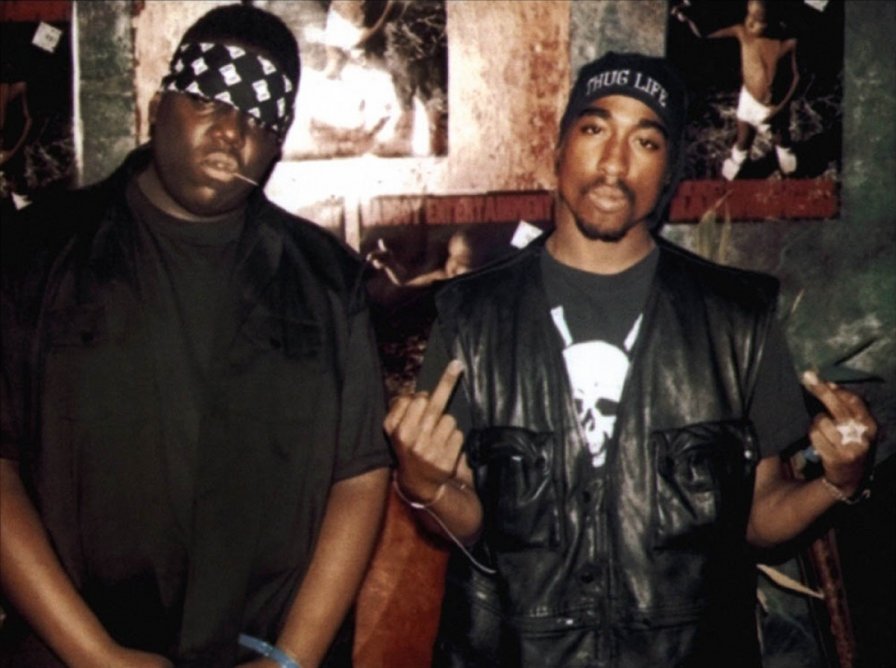
Of course, insofar as mass culture is the product of both the media and corporations like the Big Three music publishers, feuds were always a little fake. That said, even if one of the most documented feuds — the conflict between Tupac Shakur and the Notorious B.I.G. — was nudged by the release of mass-produced albums containing diss tracks and by a press that continually reported on the animus between the two rappers, it definitely wasn’t orchestrated in the manner of today’s so-called differences. Back in 1994, when Tupac was shot five times and consequently suspected Christopher Wallace (a.k.a. Biggie Smalls) of setting him up, beefs were potentially dangerous, bottom-up affairs that most likely would’ve continued even if there hadn’t been a mass media to fan their flames. The rivalry between East Coast and West Coast hip-hop potentially (yet still allegedly) precipitated the deaths of both Shakur and Wallace, while other less fatal contests still possessed a measure of autonomy, spontaneity, and — as Nas put it in a 2014 interview with Zane Lowe — “importance.”
And Nas should know, involved as he was in an ongoing spat with Jay Z that reached its apex with 2001’s “Takeover,” in which he was informed by the “H.O.V.A.” that he “fell from “Top 10” to “Not mentioned at all.” Yet, aside from the world of rap he inhabits, rock was also privy to feuds that weren’t as manufactured as they are now in 2015. At the 1992 VMAs, for example, the enmity between Kurt Cobain and Axl Rose almost resulted in fisticuffs, while at the 2007 edition of the ceremony it went one step further for Kid Rock and Tommy Lee. Similarly, the longstanding feud between Dave Mustaine and Metallica began after Mustaine was kicked out of the band in 1983 for his drunken and violent behavior, which included punching James Hetfield in the mouth.
Admittedly, most rock musicians weren’t quite as violent or aggressive in their past bickering as Mustaine’s or Kid Rock’s examples would suggest (with perhaps the honorable mention of Jack White). However, despite their relative mildness, their entries into the history of the feud contained appreciable quantities of genuine impulsiveness and animosity, both of which qualified their quarrels as extensions of the self-expression inherent to their art, and both of which stand in marked contrast to more recent instances of celebrity squabbling.
Enter the Internet
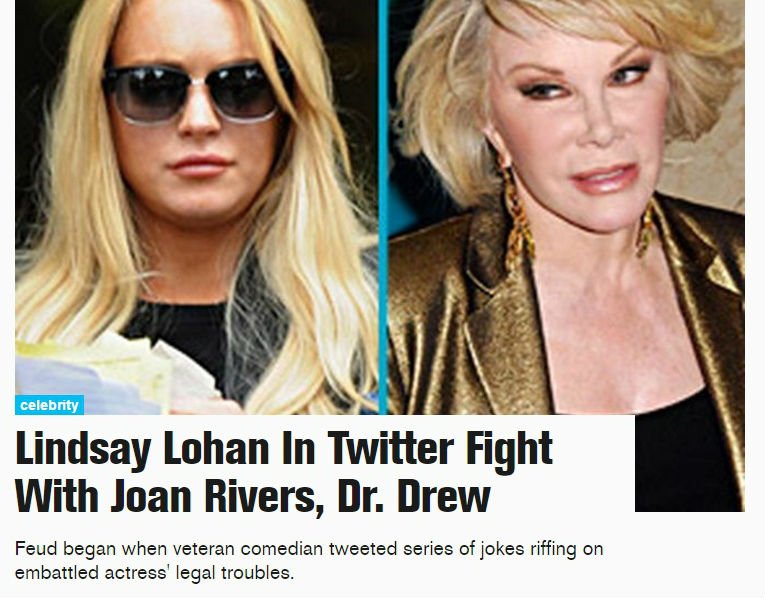
As for these recent feuds, they began to emerge with the flourishing of the internet and social media. This is especially true when it comes to Twitter, which since 2006 has enabled musicians and celebrities to connect with each other and blather to a prodigious degree. From this inauspicious year, such luminaries as Courtney Love and the Veronicas in 2009, Joan Rivers and Lindsay Lohan in 2010, Lily Allen and Cheryl Cole in 2012, and Joey Bada$$ and Lil B in 2013 have slung mud at each other across cyberspace, often bringing their fans and followers along for the ride. Far from being titanic struggles between intellectual or artistic heavyweights that involved the frank debate over ideas, principals, or beliefs, these altercations involved petty insults and cheap jokes right from the start.
For instance, in reference to Lindsay Lohan’s encounter with the firm hand of the law, Joan Rivers quipped, “Lindsay Lohan said she wouldn’t mind being under oath because she thought Oath was a Norwegian ski instructor.” Being no less edifying than the late Ms. Rivers, Courtney Love devoted her feud against the Veronicas to the passing complaint that the Australian duo had stolen her wardrobe, a subject that demonstrates how Twitter and other social media have allowed notables to publish their idle thoughts so easily that the level of the ensuing “conversation” and “discourse” has descended as a result.
As vacuous as these first forays into the world of Twitter sparring might have been, things have only worsened since the earlier years of the social network’s life. However, contrary to what some aggrieved commentators have implied (“Musicians act on impulse”), the reason why the upsurge in social media use has brought culture to the point where feuds are now a streamlined, routinized part of the machine is not simply that such media has afforded musicians and celebrities more opportunities to mock each other, but that they’ve also afforded the press more opportunities to detect, witness, and report on their trivial exchanges. Thanks to the existence of Twitter as a voluntary mass surveillance device, gutter-sniping blogs like Inquisitr, Star Pulse, KpopStarz, and Reality Tea were able to quickly pick up on this year’s tussle between, say, LeAnn Rimes and her husband’s ex-wife, and then gossip about it for the salivation of their readers.
Indeed, this is why feuds became so ubiquitous in 2015: not because musicians or the human race have become more argumentative as a species, but because a skyrocketing number of online publications learnt that they can very easily and rapidly swoop in on social-media face-offs. Even better, they also realized that such face-offs are a fantastically inexpensive and abundant source of clickbait, a source increasingly necessitated by the business models employed by most online publications nowadays. With feuds, they realized that they could attract even more visitors and post even more “content,” thereby attracting the advertisers they depend upon for their streams of revenue.
This is why the likes of PopSugar and Mashable jumped over themselves to run stories on the “Twitter fight” between Calvin Harris and Zayn Malik, a difference of egos that turned on whether musicians should be compensated more equitably for the music they provide to Spotify and other streaming services. What was interesting about this and other similar episodes was that, aside from demonstrating the willingness of websites to construe even the feeblest of confrontations between celebrities as a “feud,” it demonstrated how such a willingness reduced an argument about a potentially important issue (the music industry and its economic fairness) to the level of a playground scuffle.
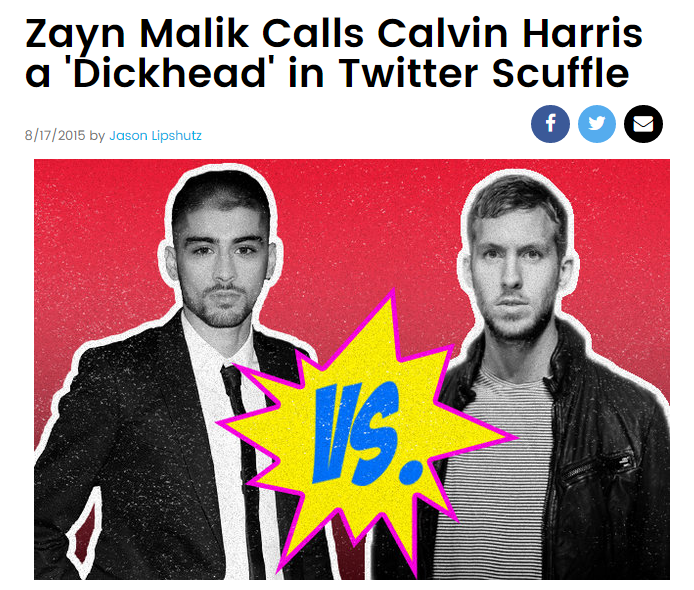
Instead of weighing up what each side of the skirmish stood for, instead of considering whether upping artist royalties might be a good thing, Mashable’s coverage of the “story” took a magnifying glass to the use of the word “dickhead”and to how Harris’s girlfriend, a certain Taylor Swift, had once dated Harry Styles, who was Zayn Malik’s former bandmate in One Direction. The same heights of forensic scrutiny could be found in Billboard’s treatment of the affair, which ran with the headline of “Zayn Malik Calls Calvin Harris a ‘Dickhead’ in Twitter Scuffle,” rather than with, perhaps, “Zayn Malik and Calvin Harris Argue Over the Merits of Streaming.” While the actual header was probably better suited to the tone and quality of the “debate” between Mr. Malik and Mr. Harris, the fact that it came from a quote-unquote “trade magazine” is a somewhat disconcerting indication of the degree of awareness in 2015 regarding such matters as record-label avarice.
Not only that, but it’s a somewhat disconcerting indication of how the base appetite for feuding has conquered any interest in what artists and celebrities feud over, of how such nouns as “feud” are used to deflect attention away from any serious concerns that might be at stake and to redirect it onto the pettiness of egos and taunts. This could be seen with the Nicki Minaj-Taylor Swift encounter, which began in July when Minaj protested that her “Anaconda” video was deprived of a VMA nomination in the Best Music Video Category because it didn’t “celebrate women with very slim bodies.”
Rather than write an article on the basis of this tweet alone and the prejudices it cites, the media was brought to life only when Taylor Swift assumed it was crabbily directed at her and her VMA nomination in the Best Music Video category. She complained to Minaj via Twitter (always the best place to resolve interpersonal problems) that “It’s unlike you to pit women against each other,” and from there a thousand websites had their news sections all fitted out for a day or so. Buzzfeed declared that the two were “Going At It On Twitter” and Business Insider proclaimed that they had “just duked it out,” while even that bastion of reputable journalism — The Guardian — defined the event as the trading of “Twitter barbs” rather than as anything more substantial.
To be fair, a small minority of the websites that featured this trade dedicated a paragraph or two to the underlying controversies, yet virtually all of them framed and packaged these controversies within the prism of the “feud,” thereby lowering them to the status of mere context. Hence, they all diverted attention away from important causes, and rather than this being an accidental facet of “beef reporting,” it’s one of its essential characteristics, since by definition such beefs are always about personalities and egos rather than issues. Or to put it differently, the diversion of attention is inherent to “beef reporting,” since to define a discussion about issues as a “beef” is simply to relegate it to the level of personalities.
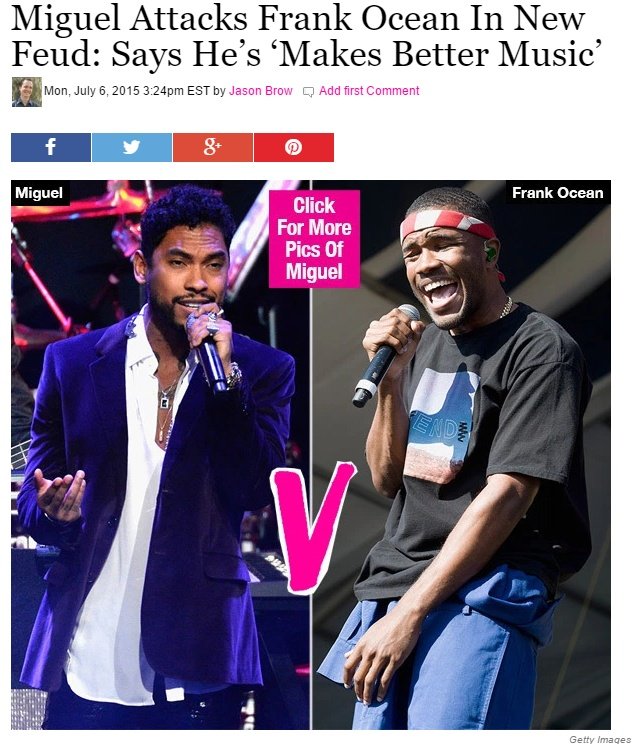
But it gets worse, because the desperation of websites to discover feuds for the delectation of their bored patrons also meant that, in addition to debasing and cheapening serious topics, they spent much of 2015 fabricating beefs out of nothing. To take a pretty flagrant case study, the website Hollywood Life published a news article in July on how Miguel had “dissed” Frank Ocean in a “new feud.” Rather than reveal a clash in a nightclub or even an exchange of acidic tweets, the so-called feud turned out to be a sub-creative way of dressing up a fairly mundane interview. Miguel was described as “picking a fight with his old rival, Frank Ocean,” not because he had actually picked a fight with Mr. Ocean, but because he had answered a probing question with the candid reply, “To be completely honest — and no disrespect to anyone […] I genuinely believe that I make better music.” The magazine’s response to this answer in the next paragraph was to write, “No disrespect, eh?”
The article then sank even lower, asking Miguel for his thoughts on whether the careers of Ocean and The Weeknd would outlast his. He responded with, “It’s interesting, but we’ll see who’s in it for the long haul. It’s like a marathon, you know?” Unless I’m insane, this seemed like quite a reasonable and measured return, yet Hollywood Life followed this quote by the mind-boggling encapsulation: “Shady!”
There’s an outside chance that such a commentary was tongue-in-cheek, but given the earnest (yet grammatically incorrect) headline and the ubiquity of similar items, it becomes all-too apparent as to how cheaply and effortlessly publications like Hollywood Life have been spinning even the most innocent of happenings and statements into “beefs.” Since they appear to have an inexhaustible hold on the public’s imagination, and since they can be concocted out of anything celebrities say about each other that isn’t incontrovertibly positive, the media have been “documenting” them whenever they have nothing else to post.
Creating Connections Between Our Clients and the Audiences Important to Them
That their scouting for likely candidates became systematic in 2015 should be apparent from the increased quantities of purported feuds blog and zines chronicled over these past 12 months, from the lukewarm acrimony between P!nk and Demi Lovato to the bald-baiting of Blake Shelton versus Adam Levine. Yet access to the inner workings of the media machine also disclose a number of muckrakers conniving assiduously behind the scenes to transform the world into a scandal.
Somewhat unsurprisingly, one of the guiltiest culprits of such muckraking for the sake of numbers is the PR and marketing industry, who in a convulsive bid to increase the fortunes of their clients even lobby more esoteric zines like Tiny Mix Tapes to cover nonexistent disputes. For one example, DKC News — apparently one of the “top 10 independent PR firms in the US” — emailed Tiny Mix Tapes to write a news story about yet another interview in which, this time, Keith Richards “bags on the Beatles and calls Sgt. Pepper rubbish.”
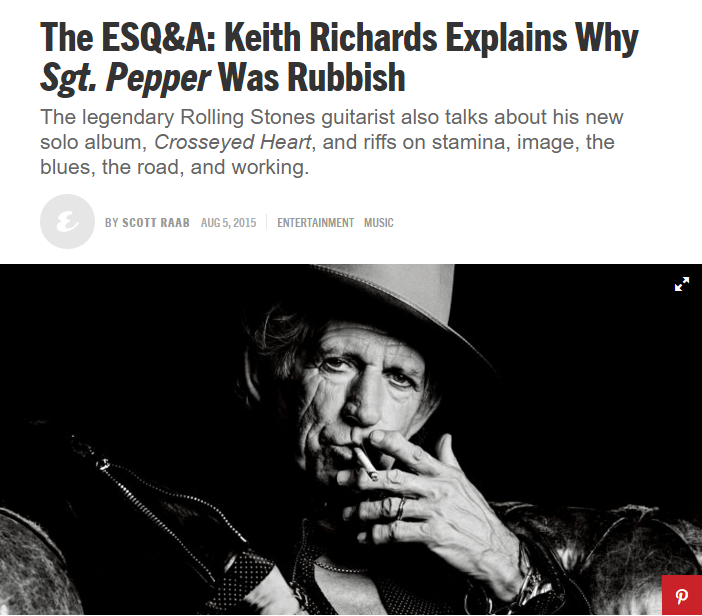
The interview had been published in Esquire, which is shown by the DKC News website, funnily enough, to be one of their clients. What’s more, they are very lucky clients indeed, since even though the request for publicity could barely have been tawdrier or more pitiful, and even though this blog somehow resisted the incredible temptation to lavish attention on a competitor, other websites seemed to have no qualms about taking the bait. Consequence of Sound plumped for a headline, which ran, “Keith Richards trashes The Beatles’ Sgt. Pepper’s album, calls it ‘rubbish,’” Rolling Stone chose something very similar, and NME went with the more verbatim “mishmash of rubbish,” among many others. Meanwhile, DKC News were congratulating themselves on a job well done, having established “connections between our clients and the audiences important to them” simply by inventing a storm in a teacup.
How often they and other PR firms goad publications into dressing up news as salaciously as possible is beyond the scope of this article, yet it might suffice simply to note that numerous magazines other than Esquire have either external or internal public relations help. For instance, DKC News also represents Billboard, who have spent much of the year dishing out stories of feuds left, right, and center. Furthermore, despite the unlikelihood that PR gangs spend all their time rustling up stories related to put-downs and arguments, it’s equally unlikely that they conduct their work in an ad-hoc, unmethodical, and irregular fashion, meaning that tipping off editors to beefs has, in 2015, become a formal, methodical, and regular part of the promotional toolkit for some. This isn’t any surprise, since the job of PR firms or directors is less to care about the profundity of a news story and more to care about how many people it can coax through the proverbial doors. Thus, they send the media a plentiful supply of requests for the most attention-grabbing coverage of their clients’ output as possible, becoming a significant factor in this year’s hike in schoolyard scrapping.
Playing the Game

This is doubly true for any PR personnel attached to musicians and celebrities themselves, and increasingly true for any musician or celebrity who wants to take the plugging of their latest masterpiece into their own hands. For one, there are smaller acts like Fat White Family, who in late August entered something like a feud with Mac DeMarco after “threatening” to join ISIS in Syria if DeMarco didn’t exit the world of music. It’s quite likely that they were attempting to bask under the Canadian’s expanding glory, to siphon off some of the fanfare now hovering around him, since they had in 2014 also lambasted Alex Turner — the frontman of the much more popular Arctic Monkeys — for being “a moron.” Their singer, Lias Saoudi, had ended his diatribe against Turner by saying, “Massive cock. Print that,” and the fact that he asked to have his words printed attests to how he knew exactly what he was doing.
Other performers know exactly what they’re doing as well, a contention supported by the observation that many of the feuds in 2015’s music universe revolved around a certain Taylor Swift, who’s the biggest pop star in that universe right now. This year, the “Bad Blood” singer was caught up in an imbroglio with Nicki Minaj, in a trading of “blows” with Katy Perry, in a faint continuation of her grievances with Diplo, and in a butting of heads with Miley Cyrus.
Or, to speak more accurately, these performers (and others) all directed venom in her general direction, regardless of whether she actually returned in kind. Consciously or not, they all received more attention than they would have if they’d belittled, say, John Searle. More to the point, in view of their fortuitous gravitation toward the most followed singer currently residing in the Western world, it’s hard to deny the conclusion that there was, if not an outright intention to their acts, at least the awareness that their unkind words would have the added benefit of attracting more eyes their way.
Such awareness illustrates how 2015 can be defined as the year in which musicians and celebrities learnt how to use feuds to their advantage. With their new learning, with their new aptitude for posting Twitter comments at just the right time and inserting juicy statements about the right people into their interviews, they contributed to a process that saw beefs codified into a superficial formula, into a rote method for manipulating the public’s interest. 2015 saw the beef transmuted into a form of celebrity “networking,” as a way for musicians and celebrities to pool their respective fan bases together.
This is particularly evident with the Nicki Minaj-Taylor Swift rumble, which according to a Huffington Post article by the CEO of Fifth Avenue Brands PR actually saw them gain more followers on Twitter and concomitantly strengthen their “brand images.” They both gave the baying public what they wanted — “bad blood” — and for their efforts, they were each rewarded with more of the baying public.
Schadenfreude and Simulacra
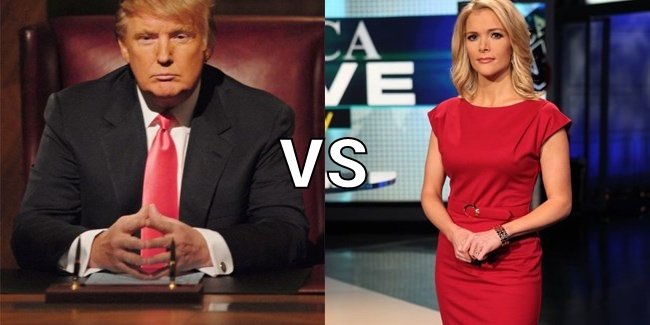
But one question remains: why is the “baying public” interested enough in feuds to be vulnerable to the connivances and machinations of the press, the PR sector, and the notables who do all the feuding? Well, as speculative as an answer to this question must surely be, there is evidence that corroborates the old view that the anonymous public enjoy it when the famous are knocked off their pedestal.
Specifically, a 2014 study in the North American Journal of Psychology (Green et al., 2014) discovered that people who score high for “interest in celebrities” also tended to exhibit higher levels of “materialistic values and envy” (my emphasis), while a 2014 paper in Celebrity Studies detailed that one of the main roles of celebrity gossip is its enabling of “mockery, pity and hostility towards celebrities” (Fronen, 2014). Taken together, such investigations bolster the idea that the public’s increasing obsession with celebrities (O’Neill, 2012) serves to facilitate envy-busting feelings of schadenfreude (Littler & Cross, 2010). Taken one step further, they also offer support for the assertion that the increasing tendency toward celebrity gossip and envy has fed into, and is being fed by, this year’s explosion in feud news.
Given this relationship, it becomes clear that the feud essentially functions as a “mini-scandal,” as a shaming, ridiculing, and slandering of people whose notoriety is more or less envied by the general public. It grants this public the opportunity to experience a fleeting sense of justice or vindication, to sit back as at least one lucky celebrity is humiliated and brought back down to earth. It drools over the spectacle of once-perfect idols being stained by jibes and jeers, and consequently feels a little better about its own imperfections, anonymity, and insignificance in the mainstream media world.
It almost goes without saying that such an impression of justice is entirely illusory. Not only are the musicians implicated in feuds not being damaged or besmirched by the dirt thrown at them, but their reputations and fame are being heightened even further, as the turbulence between Taylor Swift and Nicki Minaj evinced. The public thought they were being awarded the rare chance to see both songstresses humbled by articles adverting to a so-called argument between the two of them; instead, this public’s excitable hunger for feuds was harnessed so as to achieve the exact opposite.
In other words, the attention they lavished on the feud worked only to boost the standing and success of the parties wrapped up in it, providing these parties with extra attention, followers, and (most probably) revenues. Thus, instead of chipping away at anyone’s fame or at the massively unequal media machine itself, the public’s desire for schadenfreude played right into the hands of their manipulators.
In light of this deceptive and frustrating turnaround, the feuds of 2015 expose themselves for what they really are: the simulation of criticism and scrutiny. They are the hollow, superficial pretense of criticism, a veiled decoy for a critical engagement with media, culture, and politics that has long since disappeared (if it ever existed) from the public arena. Clothing Meek Mill’s indictment of Drake or Action Bronson’s “ruckus” with Ghostface Killah in July as personal feuds counts as little more than an attempt to satisfy public demand for hard-hitting, denunciatory analysis without actually satisfying it. Too scared to call celebrities and their industries to account with any tangible force or penetration, on- and offline publications have simply flooded the market with a cheap, ersatz substitute, hoping this substitute will placate the general public without displeasing the musicians, labels, and corporations on whom they parasitically depend.
And this substitute is certainly not unique to the music industry, as 2015 has also been the year when the political “beef” became an increasingly diversionary front for the withdrawal of sustained, issue-focused political debate. It saw the Governor and Mayor of New York City “feud” over transport finances, Texas politicians and businesses “feud” over Medicaid expansion, Republican presidential candidates “feud” over 9/11, Republican presidential candidates “feud” yet again, and US senators “feud” over the extent of NSA surveillance powers.
Even if the actual substance of these arguments were covered to some extent by the media, the adjustment in emphasis more toward their “feuding” elements indicates a personalization of politics, a dumbing down that could potentially distract public attention away from the serious challenges at hand and toward irrelevant egos. That this is happening at all suggests that, as if with music and popular culture, even consequential debate, criticism, and analysis is being gradually usurped by its inconsequential simulacrum.
Lowest-Common Denominator

Does this mean that 2015 will give way to subsequent years that see only the merest sham of journalism and engagement? Probably not, but on the other hand, there’s reason to believe that the frequency and volume of beefs will increase, perhaps to such an extent as to compel once feud-shy outlets to report on the latest Twitter nonsense, so as not to lose advertising and other revenue streams.
That’s because, as the number of musicians, artists, and celebrities peak beyond its already superfluous level, they might feel the increasing need to resort to unorthodox tactics to individuate themselves from the pack. This would become doubly true, considering how their expanding numbers would mean that there’d be even less to differentiate Act 203212 from Act 203213 on a purely artistic level. And even if this doesn’t occur on any grand scale, the growing quantities of zines, websites, and blogs all competing against each other will also entail a continued elevation in beefs. And the more these publications methodically gravitate toward social media and monitor the accounts of any remotely newsworthy celebrity, the more they will spin any imperfectly civil exchange of words into a “feud.”
This would be especially true if they need to maintain ever-higher turnovers of content and of advertising, which together drive a reliance on the cheapest possible sources of vaguely salacious “news” and vaguely titillated readers, which in 2015 just so happened to be celebrity run-ins. As harmless as these run-ins may be in themselves, the possibility that they will swamp out more important events in the coming years is disquieting, since a stifling of awareness and discourse could follow, with almost any issue being whittled down to a meager butting of heads.
Hopefully this won’t be the case, since things are already bad enough in 2015. Instead of conversations, debates, and culture, “The Year of the Feud” has given us the vanities of Drake, Meek Mill, Taylor Swift, Nicki Minaj, and Donald Trump for company. It’s given us sensationalism, triviality, and vulgarity, when just below the surface there was a world of substance, complexity, and richness waiting to be discovered. Maybe we’ll regain such a world next year, underneath all the tweets, news articles, and blogs that compete with each other to see who can reduce everything to the lowest-common denominator. But if we do manage to find it, you can bet your bottom dollar there’ll be someone waiting in line to turn it into a feud story.
More about: 2015, Action Bronson, Black Keys, Calvin Harris, Demi Lovato, Drake, Fat White Family, Frank Ocean, Ghostface Killah, Jack White, JAY-Z, Katy Perry, Keith Richards, Kid Rock, Mac DeMarco, Mark Kozelek, Meek Mill, Miguel, Miley Cyrus, Nas, Nicki Minaj, Notorious B.I.G., P!nk, Paul McCartney, Taylor Swift, The Beatles, Tupac, Zayn Malik
We celebrate the end of the year the only way we know how: through lists, essays, and mixes. Join us as we explore the music that helped define the year. More from this series



